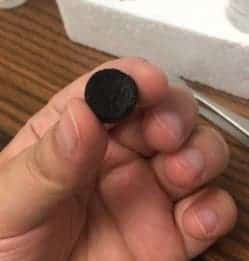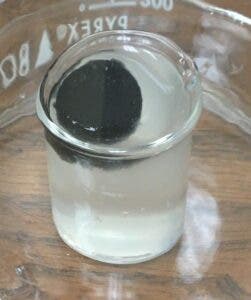Researchers from the University of Texas at Austin have come up with a new way to rapidly purify contaminated water. They’ve devised a simple hydrogel tablet that can disinfect a liter of river water and make it drinkable in just one hour. The new approach could be significant for the millions of people across the world that lack access to clean drinking water.
Municipal water disinfection using chemicals, such as chlorine (Cl2), chloramines (NH2Cl, NHCl2), chlorine dioxide (ClO2), ozone (O3), is currently used worldwide due to its efficacy and low cost. However, this process can lead to the formation of potentially toxic byproducts, which can be detrimental to human health if proper filtering isn’t in place — this may not be the case in some low-income regions or countries. Alternatively, thermal-based water treatments can also remove most contaminants by repeated boiling, but this requires a lot of energy and centralized infrastructures for wide-scale distribution of clean water.
Looking for other alternatives, a group of scientists have developed anti-bacterial hydrogels. These generate hydrogen peroxide that neutralizes bacteria with an almost 100% efficiency rate by reacting with activated carbon particles that disrupt the metabolism of bacteria. It doesn’t need any energy and doesn’t create toxic byproducts.
“Our multifunctional hydrogel can make a big difference in mitigating global water scarcity because it is easy to use, highly efficient and potentially scalable up to mass production,” Guihua Yu, an associate professor at the University of Texas at Austin and co-author of the new study, said in a statement.
The hydrogels are cheap, the researchers argue, and they can be adapted for a wide range of applications. The synthesis process is very simple and and the tablets can be manufactured using existing technology. That’s why scaling up their use wouldn’t be difficult and the range of microorganisms that they could neutralize is tweakable.
The researchers are optimistic that the hydrogels can also improve the process of solar distillation — using sunlight to separate water from contaminants via vaporization. The hydrogels could prevent the distillation systems from running into malfunction problems because of the accumulation of bacteria on equipment.
The challenging access to clean water
Clean water has long been an international goal. Millions of deaths are reported annually in developing nation as a result of diseases caused by the consumption of unsafe water that contains pathogenic microorganisms. The global population growth and the ongoing pandemic have heightened the challenge of safe water access.
Whether it’s for domestic use, food production, drinking or recreation, clean water is very important for public health. Better access and management of water resources can boost countries’ economic growth and reduce poverty. The UN General Assembly explicitly recognized the universal human right to water and sanitation back in 2010.
Contaminated water is linked to the transmission of diseases such as polio, cholera, diarrhea, hepatitis A and dysentery. Over two billion people use a drinking water source that has been contaminated with feces, while about 785 million people don’t have a basic drinking-water service, including 144 million that rely on surface water.
Water supply systems could face further problems in the medium-term because of climate change, population growth, demographic changes, and urbanization. According to the World Health Organization (WHO), half of the world’s population will be living in areas with a high level of water-stress. This will make the reutilization of wastewater an important strategy.
The study was published in the journal Advanced Materials.




